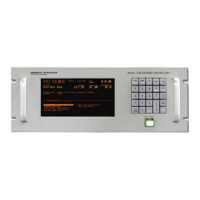Overview
2.9.6 Orbital Element Track (Optional)
The Orbital Element Tracking (OET) mode allows the user to input a Cartesian orbital
element set to be used in an open loop pointing of the antenna over time. This
tracking mode is available as a target and can be set up from the front panel or the
M&C interface. To use the OET mode the operator first creates an OET target by
inputting Cartesian orbital elements at a specific epoch in the True Earth Mean
Equinox (TEME) reference system. This element set has the general format of
Date/Time, X position, Y position, and Z position, X velocity, Y velocity and Z
velocity.
Built in sanity checking is available in the form of expected means with acceptable
tolerances. The user can enable or disable individually checks on the following
characteristics: Semi-major axis, Eccentricity, Inclination, Right Ascension of the
ascending node, and Argument of Perigee. If the input orbital elements differ from
the enabled check by more than a preset tolerance, an error is issued and the orbital
element set is not used.
When the tracking mode is executed the ACU uses built in propagators and the real
time clock to calculate look angles for antenna pointing in real time. Two built in
propagators are available in the 7200 series controllers. The first is a two-body
propagator based on Keplarian motion. The second is a multi-body propagator that
includes the effects of Moon and Sun gravitational forces and a 4x4 Geopotential
model. The system uses the Two-Body for all start up look angle calculations and
switches to the Multi-Body when the element set has been brought up to real time.
New look angles can be calculated as frequently as every ½ second out to every 120
seconds.
For proper operation of the OET mode it is important that the site information stored
in the ACU be as accurate as possible. This means it should be acquired from site
survey information or averaged from a GPS receiver. The built in clock must be set to
UTC time and updated once each day. Note: The internal real time clock can only be
set to the second and at worst case could drift 1 second per day. The ACU read outs
should be carefully calibrated to the local azimuth/elevation reference system. The
frequency at which new element sets should be input to the ACU will depend greatly
on the type of orbit represented. At minimum new elements must be provided each
time a satellite maneuver takes place. The propagators will also deviate from real life
over a period of time. This could be days, weeks or months depending on the orbit in
question.
2-30

